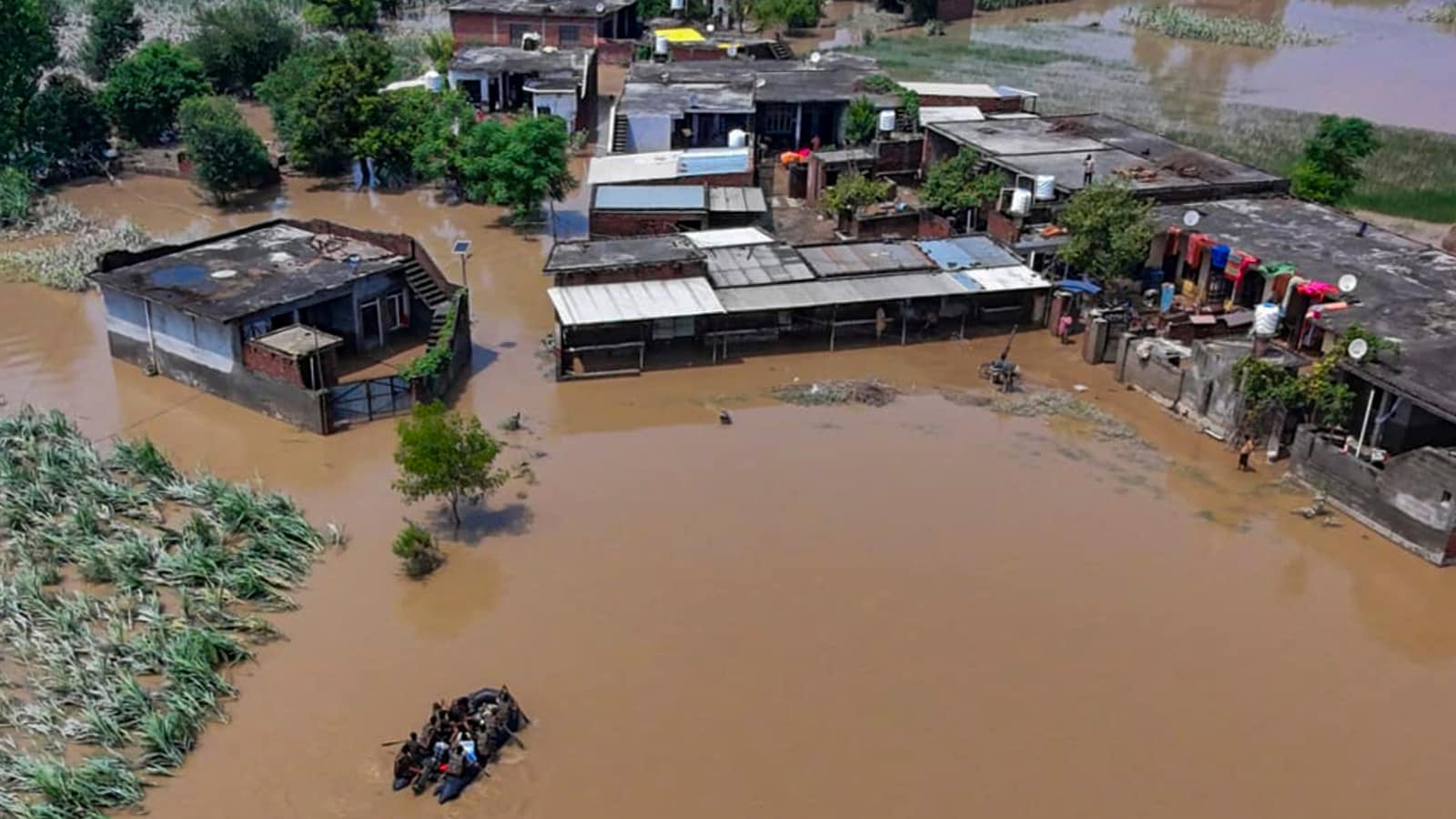By Indra Shekhar Singh,News18
Copyright news18

India for the past few years has been experiencing unprecedented blows from the weather. The vagaries of the weather seem to be quite rebellious, breaking all conventional patterns and predictions. From repeated extreme floods, cloud bursts to facing usual cyclones like Biparjoy (2023), India has been thrown off-track weather-wise. So, what’s the cause? Is it all Nature or perhaps something man-made?
Let’s review the eerie weather again. Himachal Pradesh reported 45 cloudbursts and 95 flash floods this year. Punjab got 75 per cent more rainfall than it does annually, while the floods are being compared to the great flood of 1988 in the state. India had the rainiest June and the second wettest monsoon in the past 50 years, with rainfall surpluses at 37 per cent. There were floods in Rajasthan killing hundreds and displacing thousands more, and even Gujarat received the highest rain in past 10 years. Uttarakhand and Jammu and Kashmir have the worst track record when it comes to erratic monsoon, cloudbursts and flash floods. Kedernath in 2013 was only a disastrous beginning yet a good example to elucidate this.
The monsoon has been acting in a queer way. India endured its driest August for over 120 years in 2023. Himachal Pradesh saw the driest October in 2024 and the Southern Peninsular its sixth driest October in 123 years in 2023, with rainfall over 60 per cent below normal, attributed to factors like a weak northeast monsoon onset and the Cyclone Hamoon. Meghalaya’s Sohra, considered the wettest place on earth, received about 1/3rd of the rainfall it recorded in June 2025 vs June last year. One hopes it’s clear with all these examples that there is something strange happening around us.
Next come the usually warm winters in the Himalayan regions and shifting of heat and cold seasons in India. Telangana, Andhra Pradesh, Rajasthan, UP, etc reported over 50 degrees Celsius for the past couple of years. The winters have been getting shorter and warmer, which is not only confusing humans but plant life too. As a result, we experienced major crops losses in Punjab in the last few years. The wheat crop was damaged due to excessive heat, meanwhile erratic rains all across the country are bringing their share of diseases and pests to the farmers’ fields, heavily impacting our food security. Should the climate be changing so fast and so strangely?
Man-made or made in heaven?
Natural or anthropogenic climate change has also been a topic of huge discussion. Fossil fuels emissions, industrial agriculture, deforestation, etc add significantly to the warming of the planet, but when one looks at specialised weather events like the El Niño effect and mass increases in temperatures, one questions if they too are natural reactions to human activity. Fortunately, the Modi government has answered the question for us.
Former environment and climate change minster late Anil Madhav Dave in 2016 clearly stated in a written reply to a parliamentary question that “the USA has developed a type of weapon called the High Frequency Active Auroral Research Program (HAARP). HAARP strikes the upper atmosphere with a focused and steerable electromagnetic beam. HAARP is an advanced model of a super-powerful ionospheric heater which may cause the globe to warm and have global warming effect”. The US Air Force and Navy project HAARP was developed by Defence Advanced Research Agency (DARPA).
Surprisingly, the treaty convention on the prohibition of military or any other hostile use of environmental modification techniques has existed since 1978, with India and the USA as signatories. The conventions clearly prove that nations have the technology to modify the weather and potentially also weaponise it. Here we must look at the case of China, which is also a partial signatory. It says that the convention shall only apply to Hong Kong and Macao and not the rest of China.
And therefore, it spends billions in creating a cutting-edge weather modification technology and control centre that could change the weather of 5.5 million square kilometres (2.1 million square miles)—about 1.5 times the total landmass of India. China spent US$ 1.34 billion in the period 2012-2017 to support weather modification programme, launching the largest weather-control machine to be installed in the Tibetan Plateau in 2018, and others. It also claimed to have a fully functional weather modification system by 2025.
Now, if one is thinking weather modification only means cloud seeding, today’s technology is far more advanced. Even nations like Dubai are cloud seeding, whereas nations like China are already allegedly using weather modification as weapons. Dubai also showed us when cloud seeding goes wrong, it can result in cloudburst and flash floods.
The India-China clashes in Galwan Valley also had an alleged weather modification component. It was believed that China attempted to artificially create flash floods in the Galwan river to disrupt Indian infrastructure projects and military operations. It’s not the first time a nation has used weather weaponisation. The USA, during the Vietnam War, started Operation Popeye, which increased rainfall during the monsoon season to make the terrain muddy and difficult to traverse for enemy fighters.
China is already very capable as it has a functional Tianhe (Sky River) project, which is diverting water vapour and creating an air corridor making massive weather modification possible. It is estimated that this project alone can increase rainfall by 10 billion cubic meters annually. Furthermore, it plans to expand her weather modification and cloud seeding program.
There are rumours of cloud stealing, whereby diverting water vapour and making artificial rain, China could potentially take more than its share of rain and snow from neighbouring countries like India. The weather-modification machine in Tibet region is also a bigger security threat for India’s agriculture, rivers and water security as it could silently bring devastation in India.
Hence, in tactful words, India’s defence minister Rajnath Singh in 2024 said, “Climate change in the country [India] is not just a weather-related phenomenon, but the matter is related to national security”. He hinted at China without naming it in the next statement, “Certain [Indian] border states like Uttarakhand, Himachal Pradesh, Sikkim, and Union Territories (UT) like Ladakh have noticed an increase in the number of natural disasters in recent years. The Himalayas extend to other states as well, but such incidents are confined to certain states only, and we cannot ignore that.”
Geo-engineering and weather modification are a real thing, and unfortunately, our neighbour China has a huge edge over us. We have no defence against this technology currently nor first-attack capabilities. The USA and China are far advanced in the weaponisation process too. Whether this current disaster is geo-engineered climate or not, it is hard to verify because India has no metric to measure it. But one does hope that in the future, Indian defence establishments invest time and effort so we are better prepared with early warning systems, ground preparations and attack capabilities to defend our nation from geo-engineered climate events.
The author is an independent agri-policy analyst and former director – Policy and Outreach, National Seed Association of India. He tweets at @Indrassingh. Views expressed in the above piece are personal and solely those of the author. They do not necessarily reflect News18’s views.



